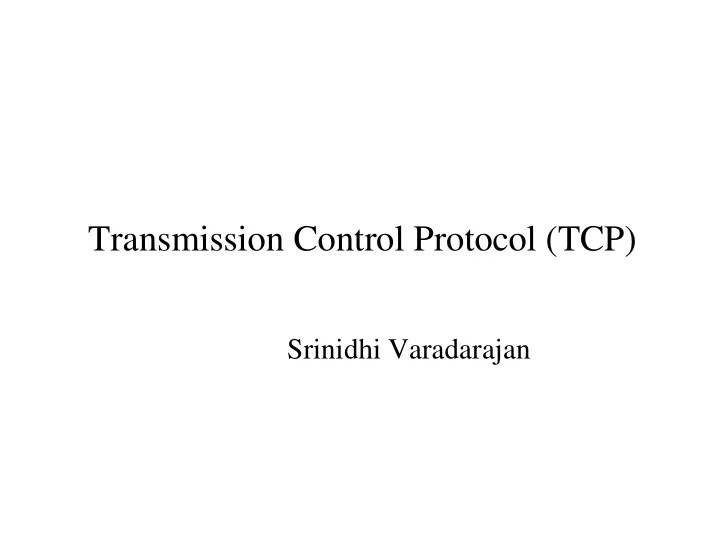

Transmission Control Protocol (TCP) Srinidhi Varadarajan
TCP: Transmission Control Protocol z TCP must perform typical transport layer functions: – Segmentation -- breaks message into packets – Error recovery -- since IP is an unreliable service – End-to-end flow control -- to avoid buffer overflow – Multiplexing and demultiplexing sessions
TCP: Transmission Control Protocol z Service provided by TCP is – Reliable – Connection-oriented -- virtual circuit – Stream-oriented -- users exchange streams of data – Full duplex -- concurrent transfers can take place in both directions – Buffered -- TCP accepts data and transmits when appropriate (can be overridden with “push”)
TCP Addressing and Multiplexing z TCP identifies connections as socket pairs – Socket address is Internet address plus port – Host Internet address provided to IP – Port uniquely identifies user or process ID on host z Example: – A connection to port 21 on 128.173.40.24 connects to ftpd (file transfer protocol daemon) on vtopus.cs.vt.edu – Port 21 is a “well known” port number and can be determined by looking at /etc/services on a UNIX machine
TCP Sliding Window Mechanism z TCP is built on top of IP, an unreliable datagram service – Lost datagrams – Out-of-order datagrams z TCP uses a sliding window mechanism for error recovery – Transmitted bytes are numbered – Receiver will accept bytes within the current “window” – Contiguous blocks are acknowledged by the receiver
TCP Sliding Window Mechanism � Sender maintains three pointers for each connection – Pointer to bytes sent and acknowledged – Pointer to bytes sent, but not yet acknowledged – Pointer to bytes that cannot yet be sent
TCP Sliding Window Mechanism z Receiver acknowledges bytes received – Specifies sequence number of next byte expected – This acknowledges all previous bytes as received error-free – Acknowledgments can be “piggy-backed” on reverse direction data packets or sent as separate packets
TCP Sliding Window Mechanism z Sender sets a timer for a segment sent – On time-out, sender will retransmit the segment – Implementations send just the first unacknowledged segment -- will wait for return acknowledgment before sending more – Implementations also typically use just one timer per connection, i.e. at any given point in time, only one segment is being timed z Time-out value is important – Bad values can add extra delays or result in wasted retransmissions – Time-out value is difficult to set since delays can vary greatly in an internetworking environment
TCP Flow Control z Flow control is needed to – Prevent sender from “swamping” receiver with data, e.g. a fast server sending to a slow client – Provide congestion control inside the network, e.g. at gateways or routers – In either case, a node can be forced to discard packets due to lack of buffer space z TCP provides end-to-end flow control – Can solve overload problems at the end node z Flow control is provided by varying the size of the sliding window
TCP Flow Control z Receiver “advertises” its window size in acknowledgments – Window size specifies how many more bytes the receiver is willing to accept – Receiver is not allowed to shrink the window beyond previously accepted bytes – Window size of 0 causes sender to stop transmission, later advertisement of a non- zero window resumes transmission z Sender will adjust its “allowed to send” pointer only as far as the advertised window
Packet Capture (tcpdump) 2:60:8c:9e:ca:b 8:0:2b:b:6c:1f 0800 62: 128.173.5.244.1524 > 128.173.5.221.21: P 171:179(8) ack 1156928647 win 2048 � � Receiver Window 8:0:2b:b:6c:1f 2:60:8c:9e:ca:b 0800 74: 128.173.5.221.21 > 128.173.5.244.1524: P 1156928647:1156928667(20) ack 179 win 16384 2:60:8c:9e:ca:b 8:0:2b:b:6c:1f 0800 60: 128.173.5.244.1524 > 128.173.5.221.21: P ack 1156928667 win 2048 2:60:8c:9e:ca:b 8:0:2b:b:6c:1f 0800 80: 128.173.5.244.1524 > 128.173.5.221.21: P 179:205(26) ack 1156928667 win 2048
TCP Connection Establishment z TCP uses a “three-way handshake” (balanced protocol) to establish a connection z Ensures that both nodes are ready and synchronizes sequence numbers
Closing a TCP Connection z A modified three-way handshake is used to gracefully close a connection
TCP Packet Format
TCP Header Fields z Source Port and Destination Port: identify applications at ends of the connection z Code Bits: – URG urgent (skip over data to urgent data) – ACK acknowledgment – PSH push request (send data to application) – RST reset the connection – SYN synchronize sequence numbers – FIN sender at end of byte stream
TCP Header Fields z Sequence Number: position of the data in the sender’s byte stream in bytes z Acknowledgment Number: position of the byte that the source expects to receive next (valid if ACK bit set) z Header Length: header size in 32-bit units z Window: advertised window size in bytes z Urgent: number of bytes to skip over in window to reach urgent (or “out-of-band”) data -- valid only if URG bit is set z Checksum: 16-bit CRC over header and data
Recommend
More recommend